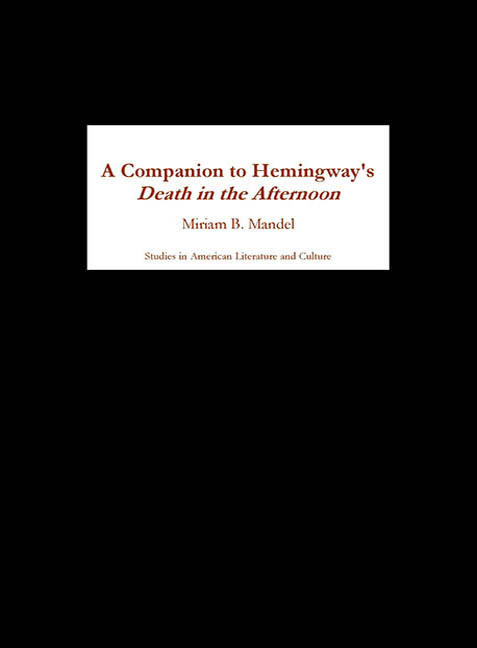Book contents
- Frontmatter
- Dedication
- Contents
- Acknowledgments
- Hemingway Works That Address the Bullfight
- A Note on the Text of Death in the Afternoon
- Introduction
- Composition, Sources, and Backgrounds
- The Composition, Revision, Publication, and Reception of Death in the Afternoon
- “Devout Again by Cynicism”: Lord Byron and Don Juan in Death in the Afternoon
- “I like you less and less”: The Stein Subtext in Death in the Afternoon
- Subject and Author: The Literary Backgrounds of Death in the Afternoon
- Reading Texts, Paratexts, and Absence
- On Authorship and Art
- And What Came After
- Works Cited
- Notes on the Contributors
- Index
“I like you less and less”: The Stein Subtext in Death in the Afternoon
from Composition, Sources, and Backgrounds
Published online by Cambridge University Press: 27 April 2017
- Frontmatter
- Dedication
- Contents
- Acknowledgments
- Hemingway Works That Address the Bullfight
- A Note on the Text of Death in the Afternoon
- Introduction
- Composition, Sources, and Backgrounds
- The Composition, Revision, Publication, and Reception of Death in the Afternoon
- “Devout Again by Cynicism”: Lord Byron and Don Juan in Death in the Afternoon
- “I like you less and less”: The Stein Subtext in Death in the Afternoon
- Subject and Author: The Literary Backgrounds of Death in the Afternoon
- Reading Texts, Paratexts, and Absence
- On Authorship and Art
- And What Came After
- Works Cited
- Notes on the Contributors
- Index
Summary
It is no coincidence that Gertrude Stein makes her appearance on the first page of Hemingway's treatise about the bullfights, their rituals, and their matadors. Had it not been for Stein, Hemingway might never have gone to Pamplona at all; might never have invested the Spanish art (and, by extension, the Spanish and Catholic cultures) with the kind of high seriousness he gave them. But in the manner that came to be typical of Ernest Hemingway, the very fact that he owed Stein some thanks for this introduction to the art of bullfighting made her suspect. Throughout Death in the Afternoon, the author-as-character shows his antipathy toward the Old lady figure who, without much of a stretch, seems to be a surrogate Gertrude. In the author-persona's use of references, names, sexual innuendoes, and comments about writing, he establishes a covert text about Stein's friends, aesthetic principles, and personal mannerisms.
Hemingway's homage to bullfighting had begun, of course, with several columns he had written for the Toronto Star. In limning the exotic — the places and scenes beyond the headily familiar aspects of postwar Paris — he drew on both his coverage of the Turkish War (and on his other European and Continental travels) and on his own leisure time activities: fishing, drinking in the cafés, skiing, and, most exotic of all, going to bullfights. As a journalist, Hemingway knew that writing about different experiences was a way to insure some publication. If those experiences were new or obscure enough, writing about them was also a way to avoid correction or contradiction.
It also seemed as if Hemingway moved under a neon sign that flashed whenever he was occupied in ways that would have most disturbed his mother, the ever-proper Grace Hall-Hemingway of Oak Park, Illinois. Going to the bullfights would have been high on her list of disreputable pastimes. We know that drinking fell into that category too, and we can imagine where Hemingway would have assumed that Grace would have listed his and Hadley's experimental lovemaking. Once Grace had moved her older son out of the family cottage, a year before he married Hadley Richardson, much of his physical and psychic behavior was aimed at getting back at his mother, at instructing her about activities she could not presume to understand.
- Type
- Chapter
- Information
- A Companion to Hemingway's Death in the Afternoon , pp. 59 - 78Publisher: Boydell & BrewerPrint publication year: 2004



